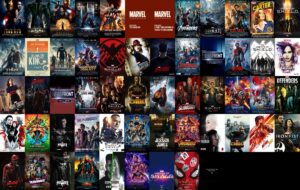MCU’s Evolving Rogue’s Gallery: Unpacking the Complexity of Recent Cinematic Villains.

- How The MCU Continues To Evolve With Each Movie
- Breaking Down The Magic: MCU’s Latest Release Has Fans Abuzz
- Unmissable MCU Magic: 10 Compelling Reasons To Catch The Latest Film
- The Best Movie Posters From Recent MCU Films
- Breaking Down The Visual Language Of The MCU’s Latest Movie
The Marvel Cinematic Universe (MCU) has long been synonymous with epic battles, legendary superheroes, and intriguing plotlines. Over the years, we’ve witnessed a new breed of villains emerge – more nuanced, multidimensional and calculated in their pursuit of power. In their latest films, MCU delves deeper into the backstories of these antagonists, deviating from conventional norms of depicting unequivocal evil. This deliberate shift highlights the creators’ efforts to produce more relatable characters, which contribute to deeper understanding and empathy.
Take, for instance, Kang the Conqueror from ‘Ant-Man and the Wasp: Quantumania’. Portrayed by Jonathan Majors, this tyrant emerges as an unexpected, yet surprisingly likable anti-hero. Kang navigates a web of complexities that tests the viewer’s perception of what defines ‘evil’ and challenges traditional heroes. Majors’ nuanced portrayal transcends mainstream notions of Kang, adopting a deep yearning for balance within an infinite multiverse. His chilling presence and conviction spark intense conversations about multidimensional power struggles.
Doctor Strange in the Multiverse of Madness saw the re-introduction of Wanda Maximoff (played by Elizabeth Olsen), whose character walks the razor’s edge between chaos and self-discovery. Despite the catastrophic events that unfold under her watch, Wanda garners sympathy from the audience due to Olsen’s compelling portrayal. The tragic, almost relatable moments of trauma experienced by Maximoff evoke a deeper understanding of her vengeful actions. These vulnerabilities inject into the audience a mixture of emotions ranging from sorrow to fear – ultimately broadening the realms of empathy.
Furthermore, not all these cinematic villains embody moral ambiguity; many characteristically root themselves in the conviction of grand, unyielding intent. Thanos, as depicted in ‘Avengers: Infinity War’, and ‘Avengers: Endgame’, stood out in his relentless pursuit of planetary equilibrium. Embodying a logic that favored intergalactic dominance, Thanos solidifies the long-held position of a zealous anti-hero consumed by purpose. Interestingly, a commonality that unites characters such as Thanos and Kang the Conqueror is that their individual ‘code’, however twisted it may seem, drives their unwavering principles.
At the core of these refreshed villainous interpretations is the incorporation of their storied backgrounds. A careful look into Kang’s long life in the Quantum Realm stirs up curiosity as the film builds Kang up gradually to provide clarity on his persona and intentions. This interweaving of anecdotes showcases one of the most unique aspects of human personality – adaptability – generating dialogue on moral balance and moral ambiguity.
As we continue witnessing this change in villainous narratives, audiences will get an enthralling glimpse into what drives human beings to fight relentlessly for what they believe is just. Delve into the emotional, tumultuous journey filled with fears, love and passions that these complexities evoke.




